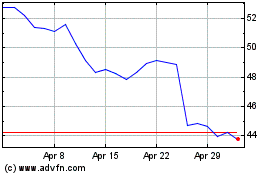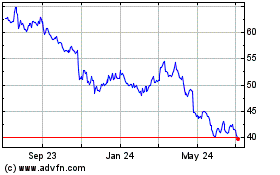Celldex Vaccine Rindopepimut Cuts Death Risk From Brain Cancer, Study Shows
November 20 2015 - 5:55PM
Dow Jones News
By Ron Winslow
The strategy of enlisting the power of the immune system to
attack cancer is showing early promise against another
tough-to-treat malignancy: the brain cancer called
glioblastoma.
In the latest development, researchers reported on Friday that a
cancer vaccine being developed by Celldex Therapeutics Inc. reduced
the risk of death from the disease by 47% in a 73-patient
randomized study. In addition, the survival rate at two years was
25% for patients given the vaccine versus none in the control
group.
It marks the first time an immunotherapy treatment has improved
survival in a randomized trial of glioblastoma patients,
researchers said. It is also among the first cancer vaccines to
show a survival benefit.
While the study was small and overall results were modest, said
David Reardon, clinical director of neuro-oncology at Boston's
Dana-Farber Cancer Institute, the findings indicate "we may have a
strategy that will move us forward for the first time in a long
time in this very challenging brain cancer."
Dr. Reardon presented the data at a meeting of the Society for
Neuro-Oncology in San Antonio. The results generally confirmed an
earlier report on the study, called React, presented in May.
The price of Celldex shares rose about 12% in Nasdaq trading on
Friday.
Pharmaceutical companies are rushing to develop
cancer-immunotherapy medicines against a wide variety of tumors,
driven by successes from Bristol-Myers Squibb Co.'s Yervoy against
melanoma and its Opdivo and Merck & Co.'s Keytruda, which treat
both melanoma and lung cancer.
About 12,000 U.S. patients are diagnosed with glioblastoma each
year, according to the American Brain Tumor Association. Until
recently, oncologists were skeptical that marshaling the immune
system against brain cancer would have much effect.
But amid widening enthusiasm for cancer immunotherapy,
researchers tried it anyway. Now the New York-based Cancer Research
Institute lists more than 30 clinical trials of various
cancer-immunotherapy approaches against glioblastoma and related
brain tumors.
The Celldex trial involves its cancer vaccine rindopepimut,
which targets a mutant protein called EGFRvIII that is present in
about 25% to 30% of glioblastoma cases. The patients in the study
carried that mutation.
The mutation is associated with poor outcomes, but it
differentiates the glioblastoma cells from normal cells. That makes
it an attractive immune-system target because it could minimize the
potential for the immune response to cause serious side effects by
hitting normal cells as well. Researchers said adverse events
associated with the vaccine were minimal.
Patients in the study had previously relapsed after treatments
other than Celldex's new vaccine. The study reported on Friday
showed tumors in about 30% of patients responded to rindopepimut,
compared with 18% in the control arm. Median survival with the
vaccine was 11.3 months compared with 9.3 months for those in the
control arm.
"They took a group of patients that are probably the toughest to
treat," Michael Lim, director of brain tumor immunotherapy at Johns
Hopkins Medicine, Baltimore, who wasn't involved in the study. "The
fact that they showed any sort of signal is very intriguing."
Despite the modest median survival gains, researchers were
struck by the durable survival in 25% of the vaccine patients. The
result is similar to the surprising long-term survival seen in
trials of Bristol-Myers Squibb's Yervoy, where about 21% of
melanoma patients survived at least three years, despite many
initially not appearing to respond to the treatment.
"Once patients are surviving long term, they don't die" of the
disease, said John Sampson, chief of neurosurgery at Duke
University Medical Center and co-principal investigator on the
study. "This is the kind of thing we look for with immunotherapy."
It will take larger studies and longer follow up to determine the
significance of that result. Dr. Sampson is an inventor of the
vaccine with a financial stake in its success.
Based in part on earlier data from the study, the U.S. Food and
Drug Administration granted the vaccine breakthrough therapy
designation last February, a status that could hasten regulatory
review. In addition, a late stage, or phase 3, study involving 745
newly diagnosed glioblastoma patients is fully enrolled, with an
interim look at the findings expected early in 2016.
Write to Ron Winslow at ron.winslow@wsj.com
Subscribe to WSJ: http://online.wsj.com?mod=djnwires
(END) Dow Jones Newswires
November 20, 2015 17:40 ET (22:40 GMT)
Copyright (c) 2015 Dow Jones & Company, Inc.
Bristol Myers Squibb (NYSE:BMY)
Historical Stock Chart
From Mar 2024 to Apr 2024

Bristol Myers Squibb (NYSE:BMY)
Historical Stock Chart
From Apr 2023 to Apr 2024
